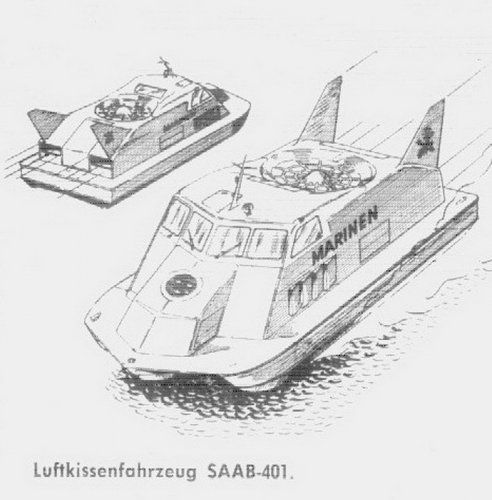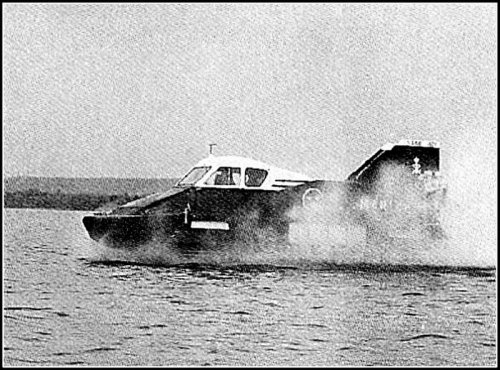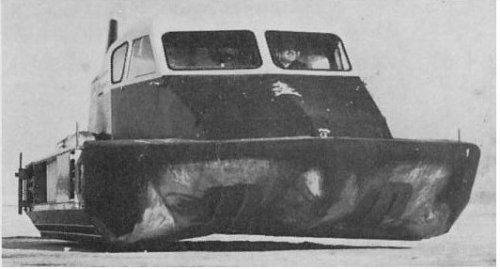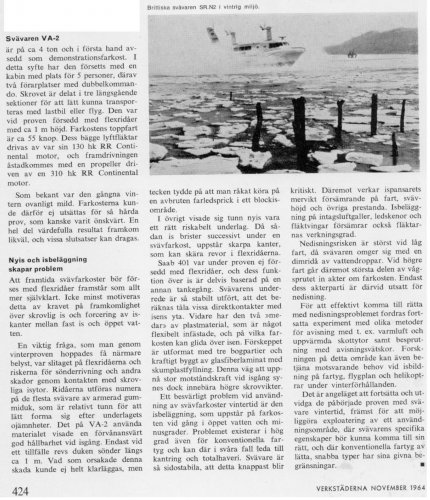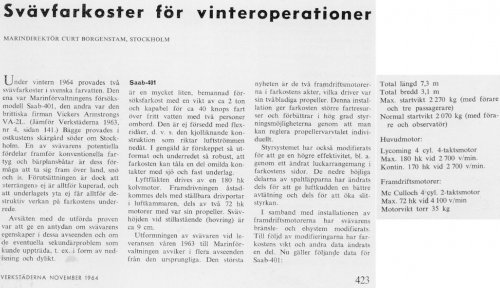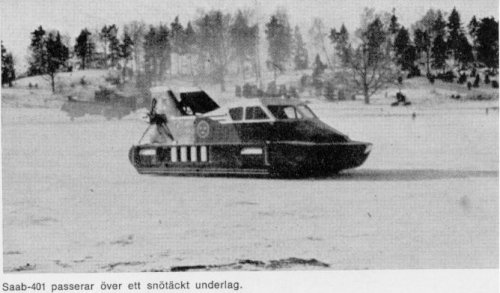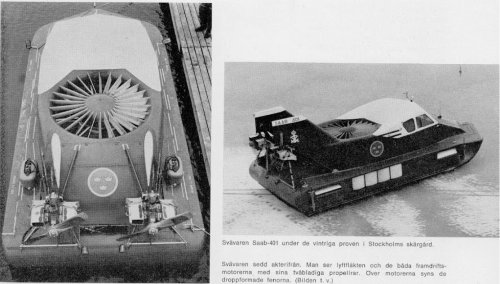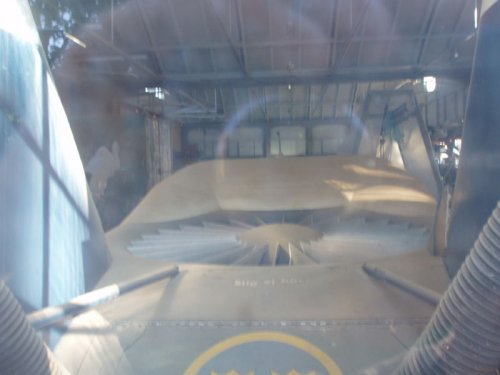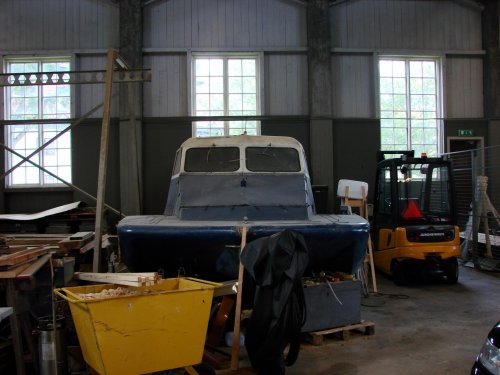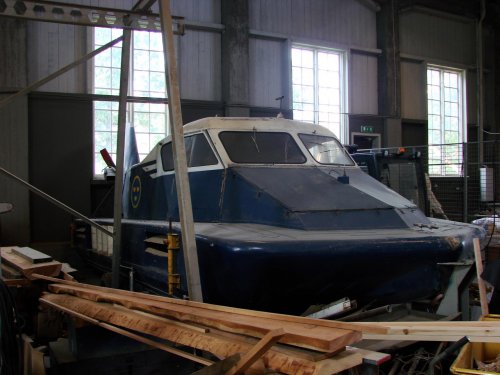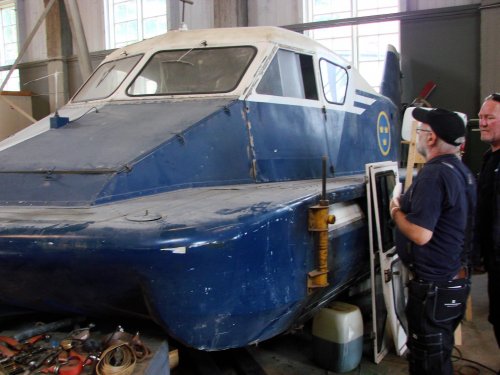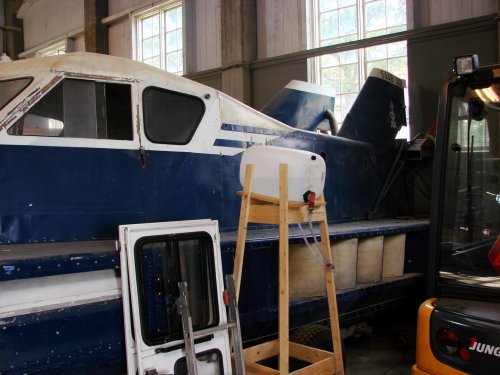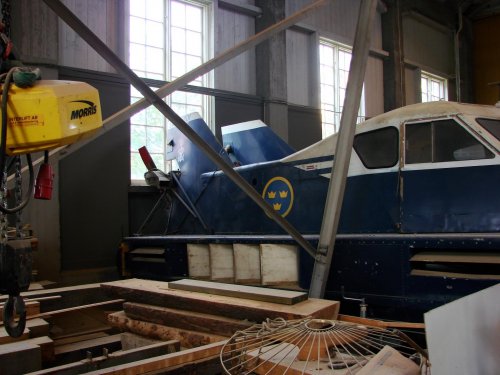Translation:
------------------------------------------------------------------------------------------
In the winter of 1964 two hovercraft were tested in Swedish waters. One was the Naval Administration experimental model Saab 401, the other was the British firm Vickers Armstrongs' VA-2L. (Compare Verkstederna 1963, page 141.) Both were tested in the east coast archipelago south of Stockholm. One of the hovercraft's advantages over conventional ships and hydrofoils is that it is able to get around on land, snow and ice. The requisite condition is that the 'terrain' not get too destructive on the vehicle's underbody.
The purpose of the tests carried out was to give an indication of A.C.V. properties in these areas and the possible secondary problems that can eventually occur, for example, in the form of icing and the like.
Saab 401
is a very small, manned experimental craft with a weight of 2 tons and capable of about 40 knots on open water with two people on board. It was not equipped with skirts, ie, the flexible construction that directs air stream downward. In return, the bow is so designed and undercarriage so robust that the vehicle can withstand some rough contact with the lake and the solid surface.
The liftfan is driven by a 180 hp piston engine. Propulsion is achieved partly with adjustable drive ports in the air chamber, and two 72 hp motors, each with its propeller. Hovering height when stationary (hovering) is about 9 cm.
The design of the hovercraft as delivered in spring 1963 to the Maritime Administration differs in several respects from the original. The biggest change is the two propulsion engines on the vehicle's stern, both of which drive a two-blade propeller. This setup gives the vehicle better performance and greatly improves the control possibilities by allowing propeller revolutions to be set individually.
The control system has also been modified to provide a higher efficiency, among others through a modified door arrangement in the vehicle sides. The flexible portions of the lower lip gap has changed so as to provide better air bag sealing and partly to increase wear resistance.
In conjunction with the installation of the propulsion engines the A.C.V.'s fuel and electrical systems were modified. Following the modifications, the vehicle weight and other data changed partly. Now, the following data for the Saab 401:
Overall length 7.3 m
Total width 3.1 m
Maximum. take-off weight 2270 kg (with driver and three passengers)
Normal take-off weight 2070 kg (with driver and observer)
Main Engine:
Lycoming 4 cyl. 4-stroke engine
Maximum. 180 hp at 2700 r / min
Continuous. 170 hp at 2700 r / min
Propulsion Engines:
McCulloch 4 cyl. 2-stroke engine
Maximum. 72 hp at 4100 r / min
-------------------------------------------------------------------------
<edit> Dug up the other page of the magazine piece - translation follows:
-------------------------------------------------------------------------
Hovercraft VA-2
is about 4 tons and is primarily intended as a demonstration vehicle. To this end, it has been equipped with a cabin with seating for five people, including two driving positions with dual controls. The hull is divided into three longitudinal sections to be easily transported by truck or plane. During the trials, it was equipped with skirts of about 1 m. Craft's top speed is about 55 knots. Both of its lifting fans driven by a 130 hp RR Continental engine and propulsion is provided by a propeller driven by a 310 hp Continental RR engine.
As you know, the past winter [1964] was unusually mild. The craft were not subject to as strict a test as might have been desirable. A lot of valuable information emerged, however, some conclusions can be drawn.
New ice and icing create problems
That future air cushion vehicles should be equipped with flexible curtains appears more and more obvious. Not least because of the requirement for mobility over rough ice and ice ridges between ice fields and open water.
An important matter, which was hoped to be explored by the winter trials, was the wear on skirts and risks of abrasion and other damage resulting from contact with rough ice. Nowadays, on most hovercraft, skirts are made of reinforced rubber, which is relatively thin to readily conform to uneven surfaces. The material used on the VA-2 showed a surprisingly good durability in ice drifts. The fabric was torn on one occasion only, along a length of approximately 1 m; What caused this damage could not be fully ascertained, but signs indicate that it happened driving over an ice covered waterway buoy.
Upturned thin ice poses a risky surface. As more and more of these ice structures are met by a hovercraft, their sharp edges can eventually cut tears in skirts.
During the tests, the Saab 401 was not provided with flexible skirts, and its functioning over ice is partly based on a different train of thought. The vehicle's chassis is so robustly done, it is expected to withstand some direct contact with the ice surface. Furthermore, the two 'skids' are of plastics material which is somewhat flexibly mounted, and on which the craft can slide over ice. The bow is designed with three bow sections and strongly built of glassfibre laminate with foam filling. This way to achieve high tolerance to ice drifts apparently, however, means more hull weight.
A difficult problem in the winter use of hovercraft is the icing that is suffered by the vehicle on open water at freezing temperatures. The problem exists largely even for conventional vessels, where icing leads to capsizing and the vessel's total loss. Hovercraft are so stable however, that this hardly becomes critical. In contrast, the extra weight of the accreted ice's weight is detrimental to speed, hover height and other performance. Ice coating on the intake air grille, vanes, rotors also impairs the fan efficiency.
Icing's risk is greatest at low speed, when hovercraft surround themselves with a screen of water droplets. At higher speeds, however, the wake's spray sticks mostly to the rear of the vessel; Only the stern is then exposed to icing.
To effectively overcome icing problem requires further experiments with different methods of deicing with eg. hot air, heated bulkhead surfaces and spraying de-icing fluids. Research in this area can also address similar icing on ships, aircraft and helicopters in winter conditions.
It is advised to continue and expand the started winter trials with hovercraft, mainly to allow the exploration of their use, which A.C.V. specific properties should be able to come into their own, and where conventional fast, light ships have their limits.
--------------------------------------------------

